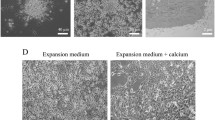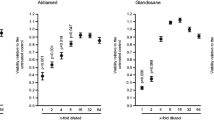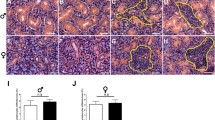Abstract
Objectives
The faecal-oral route is a predominant mode of infectious disease transmission and yet the immunology of the bovine oral cavity is poorly understood. The objectives of this study were to develop an in vitro cell model of bovine salivary gland cells and to characterize the role of vitamin D on the expression of innate immune genes induced by stimulation with bacterial and viral pathogen-associated molecular patterns (PAMPs).
Methods
Submandibular glandular tissue was excised post-mortem, processed, cells isolated and cultured until confluency after which cells were incubated with the active form of vitamin D (1,25(OH)D) for 18 h before stimulation with lipopolysaccharide (LPS μg/ml), lipoteichoic acid (LTA μg/ml) or polyinosinic:polycytidylic acid (poly I:C-20 μg/ml) PAMPs for 6 h and immune gene expression was assessed by Quantitative Real-Time PCR (RT-qPCR).
Results
RT-qPCR analysis of vimentin expression in cells derived from the bovine submandibular gland shows that cultured cells were fibroblast in origin. These cells significantly induce the pro-inflammatory cytokine IL1B, β-defensin and cathelicidin genes but these were not significantly altered in response to 1,25(OH)D. In contrast, 1,25(OH)D significantly up-regulates the expression of the NOS2 gene encoding iNOS in bovine submandibular stromal cells compared to EtOH (vehicle) control and this is a maintained response to all three bacterial and viral ligands. We have developed a new in vitro model to allow detailed investigations of mechanisms to enhance oral immunity in cattle. We show that these cells are fibroblast in nature, immunologically competent and vitamin D responsive. Their vitamin D-mediated enhancement of NOS2 expression warrants further investigation in saliva as a potential mechanism to boost oral immunity against infectious agents.



Similar content being viewed by others
Data availability
The datasets analysed during the current study are available from the corresponding author on reasonable request.
References
Ang CS, Binos S, Knight MI, Moate PJ, Cocks BG, McDonagh MB (2011) Global survey of the bovine salivary proteome: integrating multidimensional prefractionation, targeted, and glycocapture strategies. J Proteome Res 10:5059–5069. https://doi.org/10.1021/pr200516d
Bautista-Hernandez LA, Gomez-Olivares JL, Buentello-Volante B, Bautista-de Lucio VM (2017) Fibroblasts: the unknown sentinels eliciting immune responses against microorganisms. Eur J Microbiol Immunol 7:151–157. https://doi.org/10.1556/1886.2017.00009
Berghuis L, Abdelaziz KT, Bierworth J, Wyer L, Jacob G, Karrow NA, Sharif S, Clark ME, Caswell JL (2014) Comparison of innate immune agonists for induction of tracheal antimicrobial peptide gene expression in tracheal epithelial cells of cattle. Vet Res 45:105. https://doi.org/10.1186/s13567-014-0105-8
Fabian TK, Hermann P, Beck A, Fejerdy P, Fabian G (2012) Salivary defense proteins: their network and role in innate and acquired oral immunity. Int J Mol Sci 13:4295–4320. https://doi.org/10.3390/ijms13044295
Green BB, Kandasamy S, Elsasser TH, Kerr DE (2011) The use of dermal fibroblasts as a predictive tool of the toll-like receptor 4 response pathway and its development in Holstein heifers. J Dairy Sci 94:5502–5514. https://doi.org/10.3168/jds.2011-4441
Gutierrez AM, Martinez-Subiela S, Eckersall PD, Ceron JJ (2009) C-reactive protein quantification in porcine saliva: a minimally invasive test for pig health monitoring. Vet J 181:261–265. https://doi.org/10.1016/j.tvjl.2008.03.021
Hans M, Madaan Hans V (2014) Epithelial antimicrobial peptides: guardian of the oral cavity. Int J Pept 2014:370297. https://doi.org/10.1155/2014/370297
Javaid MA, Ahmed AS, Durand R, Tran SD (2016) Saliva as a diagnostic tool for oral and systemic diseases. J Oral Biol Craniofac Res 6:66–75. https://doi.org/10.1016/j.jobcr.2015.08.006
Kandasamy S, Green BB, Benjamin AL, Kerr DE (2011) Between-cow variation in dermal fibroblast response to lipopolysaccharide reflected in resolution of inflammation during Escherichia coli mastitis. J Dairy Sci 94:5963–5975. https://doi.org/10.3168/jds.2011-4288
Kelly P, Barry-Reidy A, Brewer A, Meade KG, O'Farrelly C (2020) Improved filtration method to isolate pure populations of primary bovine endometrial epithelial and stromal cells for immunological studies. Vet Res Commun 44:29–39. https://doi.org/10.1007/s11259-020-09770-3
Khurshid Z, Naseem M, Sheikh Z, Najeeb S, Shahab S, Zafar MS (2016) Oral antimicrobial peptides: Types and role in the oral cavity. Saudi Pharm J: SPJ : the official publication of the Saudi Pharmaceutical Society 24:515–524. https://doi.org/10.1016/j.jsps.2015.02.015
Mallikarjunappa S, Adnane M, Cormican P, Karrow NA, Meade KG (2019) Characterization of the bovine salivary gland transcriptome associated with Mycobacterium avium subsp. paratuberculosis experimental challenge. BMC Genomics 20:491. https://doi.org/10.1186/s12864-019-5845-4
Mathews M, Jia HP, Guthmiller JM, Losh G, Graham S, Johnson GK, Tack BF, McCray PB Jr (1999) Production of beta-defensin antimicrobial peptides by the oral mucosa and salivary glands. Infect Immun 67:2740–2745
McDougall EI (1948) Studies on ruminant saliva. 1. The composition and output of sheep's saliva. Biochem J 43:99–109
Mehta DR, Ashkar AA, Mossman KL (2012) The nitric oxide pathway provides innate antiviral protection in conjunction with the type I interferon pathway in fibroblasts. PLoS One 7:e31688. https://doi.org/10.1371/journal.pone.0031688
Murakami M, Ohtake T, Dorschner RA, Gallo RL (2002) Cathelicidin antimicrobial peptides are expressed in salivary glands and saliva. J Dent Res 81:845–850. https://doi.org/10.1177/154405910208101210
Nelson CD, Reinhardt TA, Thacker TC, Beitz DC, Lippolis JD (2010) Modulation of the bovine innate immune response by production of 1alpha,25-dihydroxyvitamin D(3) in bovine monocytes. J Dairy Sci 93:1041–1049. https://doi.org/10.3168/jds.2009-2663
O'Brien MB, McLoughlin RM, Meade KG (2020) Application of the TruCulture(R) whole blood stimulation system for immune response profiling in cattle. Vet Immunol Immunopathol 221:110025. https://doi.org/10.1016/j.vetimm.2020.110025
Rockett KA, Brookes R, Udalova I, Vidal V, Hill AV, Kwiatkowski D (1998) 1,25-Dihydroxyvitamin D3 induces nitric oxide synthase and suppresses growth of Mycobacterium tuberculosis in a human macrophage-like cell line. Infect Immun 66:5314–5321
von Bernuth H et al (2008) Pyogenic bacterial infections in humans with MyD88 deficiency. Science 321:691–696. https://doi.org/10.1126/science.1158298
Waters WR, Nonnecke BJ, Rahner TE, Palmer MV, Whipple DL, Horst RL (2001) Modulation of Mycobacterium bovis-specific responses of bovine peripheral blood mononuclear cells by 1,25-dihydroxyvitamin D(3). Clin Diagn Lab Immunol 8:1204–1212. https://doi.org/10.1128/CDLI.8.6.1204-1212.2001
Waters WR, Palmer MV, Nonnecke BJ, Whipple DL, Horst RL (2004) Mycobacterium bovis infection of vitamin D-deficient NOS2−/− mice. Microb Pathog 36:11–17. https://doi.org/10.1016/j.micpath.2003.08.008
Xue Q, Yan Y, Zhang R, Xiong H (2018) Regulation of iNOS on immune cells and its role in diseases. Int J Mol Sci:19. https://doi.org/10.3390/ijms19123805
Acknowledgements
The authors would like to acknowledge Moyvalley Meats, Kildare for their kind assistance with sample collection.
Funding
This work was funded by a Research Grant to KM from the Irish Department of Agriculture (DAFM grant 13/S/472).
Author information
Authors and Affiliations
Contributions
Conceived the study: KM. Developed primary culture model: MB, MOB and CB. Performed experiments and interpreted data: MB, MOB and CB. Wrote the manuscript: MB, MOB and KM. All authors read and approved the final manuscript.
Corresponding author
Ethics declarations
Declarations
All authors declare that they have no competing interests.
Ethics statement
All procedures described were conducted post-mortem, and for which ethical approval and licences are not required.
Consent for publication
Not applicable.
Additional information
Publisher’s Note
Springer Nature remains neutral with regard to jurisdictional claims in published maps and institutional affiliations.
Rights and permissions
About this article
Cite this article
Boylan, M., O’Brien, M.B., Beynon, C. et al. 1,25(OH)D vitamin D promotes NOS2 expression in response to bacterial and viral PAMPs in primary bovine salivary gland fibroblasts. Vet Res Commun 44, 83–88 (2020). https://doi.org/10.1007/s11259-020-09775-y
Received:
Accepted:
Published:
Issue Date:
DOI: https://doi.org/10.1007/s11259-020-09775-y




